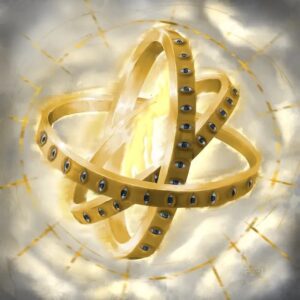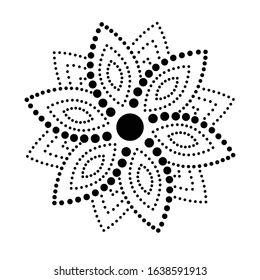Sketch
Concept Inspiration
My project, titled “Be Not Afraid,” was inspired by the concept of biblically accurate angels, specifically the Thrones (also known as Ophanim). In biblical and extrabiblical texts, Thrones are described as extraordinary celestial beings. The prophet Ezekiel describes them in Ezekiel 1:15-21 as wheel-like creatures: “Their appearance and structure was as it were a wheel in the middle of a wheel.” They are often depicted as fiery wheels covered with many eyes.
I wanted to recreate this awe-inspiring and somewhat unsettling image using digital art. The multiple rotating rings adorned with eyes in my project directly represent the wheel-within-wheel nature of Thrones, while the overall structure aims to capture their celestial and otherworldly essence. By creating this digital interpretation, I hoped to evoke the same sense of wonder and unease that the biblical descriptions might have inspired in ancient times.
Process of Development
I started by conceptualizing the basic structure – a series of rotating rings with eyes to represent the Thrones’ form. Initially, I implemented sliders for parameter adjustment, thinking it would be interesting to allow for interactive manipulation. However, as I developed the project, I realized I preferred a specific aesthetic that more closely aligned with the biblical descriptions and decided to remove the sliders and keep fixed values.
A key requirement of the project was to use invisible attractors and visible movers to create a pattern or design. This led me to implement a system of attractors that influence the movement of the entire Throne structure. This is mainly expressed in rotation around the center and more turbulent up and down movement. Values for these were adjusted to make motion smooth and graceful, corresponding to that of divine being.
As I progressed, I kept adding new elements to enhance the overall impact and atmosphere. The central eye came later in the process, as did the cloud background and sound elements. The project was all about refinement after refinement. Even at this stage I am sure there are lots of things to improve since lot of is visual representation which at times can be quite subjective.
How It Works
My project uses p5.js to create a 3D canvas with several interacting elements:
- Rings: I created four torus shapes with different orientations and sizes to form the base structure, representing the “wheel within a wheel” form of Thrones. Those wheels or rings were taken to be different values but eventually settled for four as it is not too overcrowded while delivering needed effect.
- Eyes: I positioned multiple eyes of varying sizes on these rings, reflecting the “full of eyes” description associated with Thrones.
- Central Eye: I added a larger eye in the center that responds to mouse movement when the cursor is over the canvas, symbolizing the all-seeing nature of these beings.
- Attractors and Movement: I implemented a system of invisible attractors that influence the movement of the entire structure. This includes:
- A central attractor that creates a circular motion.
- Vertical attractors that add turbulence and complexity to the movement. These attractors work together to create the organic, flowing motion of the Throne structure, evoking a sense of constant, ethereal rotation as described in biblical texts.
- Background: I used a cloud texture to provide a heavenly backdrop.
- Audio: I incorporated background music and a rotation sound whose volume correlates with the ring speeds to enhance the atmosphere.
Code I’m Proud Of
There are several pieces of code in this project that I’m particularly proud of, as they work together to create the complex, ethereal movement of the Thrones:
- The attractor system:
// Calculate attractor position
let attractorX = cos(attractorAngle) * attractorRadius;
let attractorY = sin(attractorAngle) * attractorRadius;
// Calculate vertical attractor position with increased turbulence
let verticalAttractorY =
sin(verticalAttractorAngle1) * verticalAttractorAmplitude1 +
sin(verticalAttractorAngle2) * verticalAttractorAmplitude2 +
sin(verticalAttractorAngle3) * verticalAttractorAmplitude3;
// Move the entire scene based on the attractor position
translate(attractorX, attractorY + verticalAttractorY, 0);
This code creates complex, organic motion by combining a circular attractor with vertical attractors. It achieves a nuanced, lifelike movement that adds significant depth to the visual experience, simulating the constant, ethereal rotation associated with the biblical descriptions of Thrones.
2. The ring and eye movement, including fading effects:
// Update outer ring spin speed
outerRingTimer++;
if (outerRingTimer >= pauseDuration && !isOuterRingAccelerating) {
isOuterRingAccelerating = true;
outerRingTimer = 0;
fadeOutStartTime = 0;
} else if (outerRingTimer >= accelerationDuration && isOuterRingAccelerating) {
isOuterRingAccelerating = false;
outerRingTimer = 0;
fadeOutStartTime = frameCount;
}
if (isOuterRingAccelerating) {
outerRingSpeed += ringAcceleration;
rotationSoundVolume = min(rotationSoundVolume + 0.01, 1);
} else {
outerRingSpeed = max(outerRingSpeed - ringAcceleration / 3, 0.01);
if (frameCount - fadeOutStartTime < decelerationDuration - fadeOutDuration) {
rotationSoundVolume = 1;
} else {
let fadeOutProgress = (frameCount - (fadeOutStartTime + decelerationDuration - fadeOutDuration)) / fadeOutDuration;
rotationSoundVolume = max(1 - fadeOutProgress, 0);
}
}
rotationSound.setVolume(rotationSoundVolume);
// Update ring spins
rings[1].spin += outerRingSpeed;
rings[3].spin += innerRingSpeed;
// Draw and update eyes
for (let eye of eyes) {
let ring = rings[eye.ring];
let r = ring.radius + ring.tubeRadius * eye.offset;
let x = r * cos(eye.angle);
let y = r * sin(eye.angle);
push();
rotateX(ring.rotation.x + sin(angle + ring.phase) * 0.1);
rotateY(ring.rotation.y + cos(angle * 1.3 + ring.phase) * 0.1);
rotateZ(ring.rotation.z + sin(angle * 0.7 + ring.phase) * 0.1);
if (eye.ring === 1 || eye.ring === 3) {
rotateZ(ring.spin);
}
translate(x, y, 0);
let eyePos = createVector(x, y, 0);
let screenCenter = createVector(0, 0, -1);
let directionVector = p5.Vector.sub(screenCenter, eyePos).normalize();
let rotationAxis = createVector(-directionVector.y, directionVector.x, 0).normalize();
let rotationAngle = acos(directionVector.z);
rotate(rotationAngle, rotationAxis);
if (eye.isInner) {
rotateY(PI);
}
texture(eyeTexture);
sphere(eye.size);
pop();
}
This code manages the complex movement of the rings and eyes, including acceleration, deceleration, and fading effects. It creates a mesmerizing visual that captures the otherworldly nature of the Thrones. The fading of the rotation sound adds an extra layer of immersion.
I’m particularly proud of how these pieces of code work together to create a cohesive, organic motion that feels both alien and somehow alive, which is exactly what I was aiming for in this representation of biblically accurate angels.
Challenges
The biggest challenge I faced was definitely the movement and implementing the attractor system effectively. Creating smooth, organic motion in a 3D space while managing multiple rotating elements was incredibly complex. I struggled with:
- Coordinating the rotation of rings with the positioning and rotation of eyes.
- Implementing the acceleration and deceleration of ring rotations smoothly.
- Balancing the various movement elements (ring rotation, attractor motion, eye tracking) to create a cohesive, not chaotic, visual effect.
Another significant challenge was accurately representing the complex, wheel-within-wheel structure of Thrones. Balancing the need for a faithful representation with artistic interpretation and technical limitations required careful consideration and multiple iterations.
Reflection
Looking back, I’m satisfied with how my “Be Not Afraid” project turned out. I feel I’ve successfully created an interesting and slightly unsettling visual experience that captures the essence of Thrones as described in biblical texts. The layered motion effects created by the attractor system effectively evoke the constant rotation associated with these beings. I’m particularly pleased with how the central eye and the eyes on the rings work together to create a sense of an all-seeing, celestial entity.
Future Improvements
While I’m happy with the current state of my project, there are several improvements I’d like to make in the future:
- Blinking: I want to implement a sophisticated blinking mechanism for the eyes, possibly with randomized patterns or reactive blinking based on scene events. This could add to the lifelike quality of the Throne.
- Face Tracking: It would be exciting to replace mouse tracking with face tracking using a webcam and computer vision libraries. This would allow the central eye to follow the viewer’s face, making the experience even more immersive and unsettling.
- Increased Realism: I’d like to further refine the eye textures and shading to create more photorealistic eyes, potentially using advanced shaders. This could enhance the “full of eyes” aspect described in biblical texts.
- Interactive Audio: Developing a more complex audio system that reacts to the movement and states of various elements in the scene is definitely on my to-do list.
- Performance Optimization: I want to explore ways to optimize rendering and calculation to allow for even more complex scenes or smoother performance on lower-end devices.
- Enhanced Wheel Structure: While the current ring structure represents the wheel-like form of Thrones, I’d like to further refine this to more clearly show the “wheel within a wheel” aspect. This could involve creating interlocking ring structures or implementing a more complex geometry system.
- Fiery Effects: Many descriptions of Thrones mention their fiery nature. Adding particle effects or shader-based fire simulations could enhance this aspect of their appearance.
References
- Biblical descriptions of Thrones/Ophanim, particularly from the Book of Ezekiel
- Provided Coding Train video about attractors
- Various Art depicting thrones
- General internet
- Royalty free music
- Eye texture PNG (Eye (Texture) (filterforge.com))
- https://www.geeksforgeeks.org/materials-in-webgl-and-p5-js/

Update: Added eye movement, removed torus shape, increased eye frequency
Update2: removed outer frame, increased distance to Ophanim, fog effect, 2x zoom effect, modified picture (Photoshop Generative AI). Added more extensive comments. Eye twitch movement (random).









